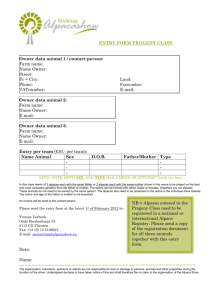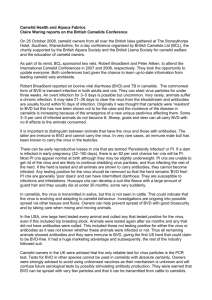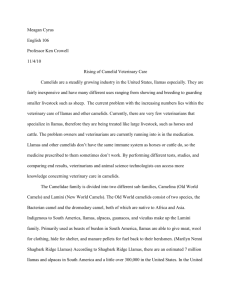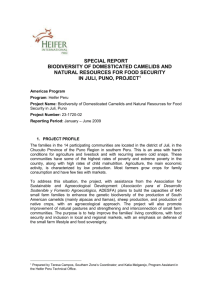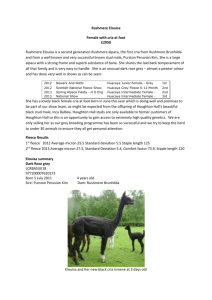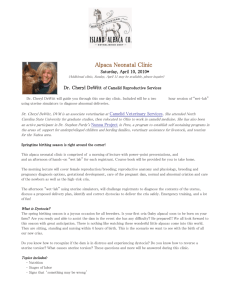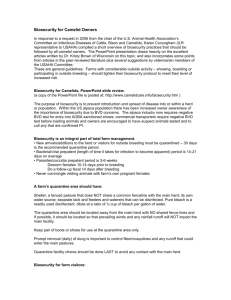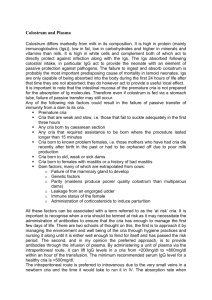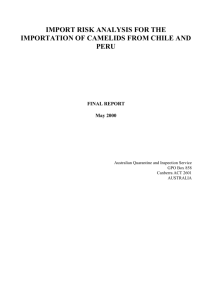2008 Camelid Conference Report
advertisement
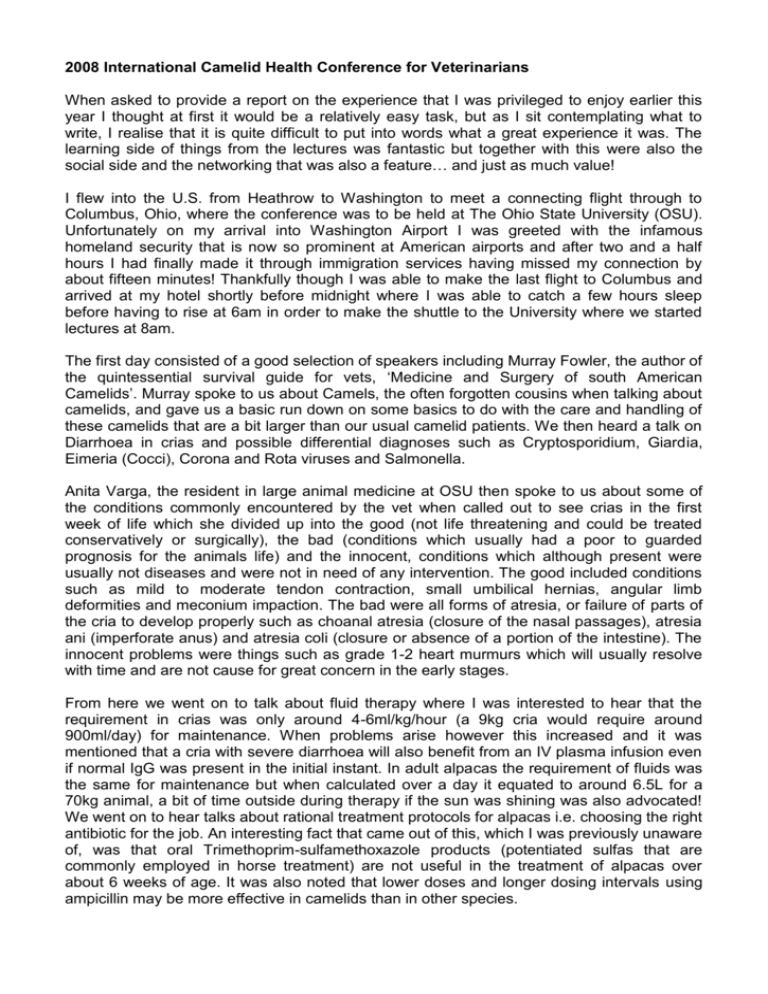
2008 International Camelid Health Conference for Veterinarians When asked to provide a report on the experience that I was privileged to enjoy earlier this year I thought at first it would be a relatively easy task, but as I sit contemplating what to write, I realise that it is quite difficult to put into words what a great experience it was. The learning side of things from the lectures was fantastic but together with this were also the social side and the networking that was also a feature… and just as much value! I flew into the U.S. from Heathrow to Washington to meet a connecting flight through to Columbus, Ohio, where the conference was to be held at The Ohio State University (OSU). Unfortunately on my arrival into Washington Airport I was greeted with the infamous homeland security that is now so prominent at American airports and after two and a half hours I had finally made it through immigration services having missed my connection by about fifteen minutes! Thankfully though I was able to make the last flight to Columbus and arrived at my hotel shortly before midnight where I was able to catch a few hours sleep before having to rise at 6am in order to make the shuttle to the University where we started lectures at 8am. The first day consisted of a good selection of speakers including Murray Fowler, the author of the quintessential survival guide for vets, ‘Medicine and Surgery of south American Camelids’. Murray spoke to us about Camels, the often forgotten cousins when talking about camelids, and gave us a basic run down on some basics to do with the care and handling of these camelids that are a bit larger than our usual camelid patients. We then heard a talk on Diarrhoea in crias and possible differential diagnoses such as Cryptosporidium, Giardia, Eimeria (Cocci), Corona and Rota viruses and Salmonella. Anita Varga, the resident in large animal medicine at OSU then spoke to us about some of the conditions commonly encountered by the vet when called out to see crias in the first week of life which she divided up into the good (not life threatening and could be treated conservatively or surgically), the bad (conditions which usually had a poor to guarded prognosis for the animals life) and the innocent, conditions which although present were usually not diseases and were not in need of any intervention. The good included conditions such as mild to moderate tendon contraction, small umbilical hernias, angular limb deformities and meconium impaction. The bad were all forms of atresia, or failure of parts of the cria to develop properly such as choanal atresia (closure of the nasal passages), atresia ani (imperforate anus) and atresia coli (closure or absence of a portion of the intestine). The innocent problems were things such as grade 1-2 heart murmurs which will usually resolve with time and are not cause for great concern in the early stages. From here we went on to talk about fluid therapy where I was interested to hear that the requirement in crias was only around 4-6ml/kg/hour (a 9kg cria would require around 900ml/day) for maintenance. When problems arise however this increased and it was mentioned that a cria with severe diarrhoea will also benefit from an IV plasma infusion even if normal IgG was present in the initial instant. In adult alpacas the requirement of fluids was the same for maintenance but when calculated over a day it equated to around 6.5L for a 70kg animal, a bit of time outside during therapy if the sun was shining was also advocated! We went on to hear talks about rational treatment protocols for alpacas i.e. choosing the right antibiotic for the job. An interesting fact that came out of this, which I was previously unaware of, was that oral Trimethoprim-sulfamethoxazole products (potentiated sulfas that are commonly employed in horse treatment) are not useful in the treatment of alpacas over about 6 weeks of age. It was also noted that lower doses and longer dosing intervals using ampicillin may be more effective in camelids than in other species. Dr. LaRue Johnson then talked us through an overview of congenital/genetic conditions of camelids (too numerous to mention) and then to end the day we heard some good information on IgG or immunoglobulins, those wonderful things the cria needs from mum in the colostrum to give it a good kick start in life by boosting its immune function! Walter Bravo discussed some recent research that has been undertaken recently to look at the molecular structure of the camelid IgG molecule, how it differs from those of other species and its role in immune function in the early days of a crias life. We then heard about failure of passive transfer (FPT) and comparative aspects of passive transfer. I could honestly say that the first day alone had been a real head full of information to take in and after arriving in the dark we finally headed back to the hotel in the dark where after a very long day sleep came quite quickly! Day two started in much the same fashion however I was able to benefit from a slightly longer sleep in as one of the other participants had a vehicle which he kindly offered to take some of us in to avoid having to get up so early for the shuttle. When he arrived at the front door to meet us I was rather in awe of the size of the ‘work truck’. Sitting in the back seat I had enough room for an armrest either side of me and leg room aplenty! In the states it seems that the big is better saying is true Day two started with a very topical subject concerning the serological detection of TB in camelids which, given the current situation here in the UK, I found very interesting. The presenter gave some very useful information about the development of a rapid assay test being developed by a company called Chembio in the states which was looking like it was going to be a much more accurate way of detecting TB in Camelids than our current techniques. Although still in the development stage it should be available in the near future all going well! Dr. Robert Van Saun then gave us a good run down on selenium levels and looked at some of the nutritional diseases associated with camelids including fatty liver disease and obesity, common problems in overfed ‘pets’ that we quite often encounter. It highlighted the need for appropriate use of body condition scoring to manage the feeding and nutritional requirements of our charges; an easy task to undertake and a good excuse to get hands on with the animals. Continuing on with the nutritional theme we heard about insulin sensitivity next and about the reduced glucose tolerance and poor insulin sensitivity that is seen in New World camelids. This has been an area of work for a while now in the states as many hospitals are using insulin therapy as an adjunctive therapy in cases where hepatic lipidosis, hyperketonaemia, high circulating NEFA (non esterified fatty acids) and hyperlipaemia are present in patients. Many of these symptoms have been noted in in-patients, either as a primary cause or secondary to other disease processes, hence the interest in the use of insulin for therapy. It has been suggested that the evolutionary benefits of insulin resistance come from the reduction of glucose consumption in times of severe feeding restrictions. Having looked at nutrition for most of the day we then took a break to consider eyes and had an interesting talk on treatment of ocular disease of camelids with good notes being provided on some of the more common procedures that could be performed. This was followed up by a talk about congenital heart disease to end the day’s lectures. We then adjourned to a neighbouring bar/restaurant to enjoy a little social time and on leaving the conference venue for the short trip to the eatery we discovered that it had started to snow outside. Thankfully it didn’t settle but the temperatures were not that high! Thursday saw us back in the lecture theatre with some interesting talks in the morning on coccidiosis and enterotoxaemia followed by a lecture on neurological diseases covering the ‘big three’ causes being meningeal worm (not present in the UK), Listeriosis and Poliencephalomalacia. An interesting discussion was then had around BVDV and specific immunological responses in persistently infected alpacas. Studies that had been done in the US indicated that those cria that were classed as being persistently infected showed similar immune unction deficits as were noted in calves that were infected. These deficits included a reduction in T lymphocytes and CD 4 cells together with a relative monocytosis when compared to healthy control animals. It was mentioned though that evidence of impairment of the immune system in alpacas was still only circumstantial ad that further testing was required before strong conclusions could be drawn. Many of those present at the talk expressed concern about the disease and the level of importance being placed on it with regards to the lack of hard data being available to confirm its relevance/importance. Much of the rest of the afternoon was spent in discussion on BVD and on further talks about it including its prevalence in the US. We concluded the day with a talk about some recent work being undertaken on drench resistance which although a very interesting talk, was based around the US scenario where the avermectin family of drench products has been potentially overused due to the problems they have with the meningeal worm that requires drenching every month in order to prevent problems in those areas where it is endemic. This over use of drench has then had a flow on effect into the enteric worm population creating drench resistance in these worms. This I believe is an area we here in Britain need to be aware of, as a rational approach to the drenching of alpacas is essential to ensure the continued efficacy of current drench products into the future. Work is currently being done in the UK at the moment with regards parasites and hopefully this will give us some more answers towards this end. Friday morning saw us begin the final day of lectures with a good talk about renal disease in camelids and it was stressed that on clinical examinations where a low protein was discovered on blood work repeated faecal egg counts should be done as common things happened commonly! Although this is a potential indicator of renal disease it is more likely to be due to parasitism! Other potential causes of renal disease was the over supplementation with Vitamin D. This can result in mineral deposition in the kidneys resulting in renal failure over time. Our next talk was on tooth root abscesses which was a very enlightening talk on one of the more common problems that can be presented to us…. The animal with a swelling under its jaw! Dr. Ahmed Tibary then took over the stand to take us through to lunch time talking about the male alpaca and the examination of him with regards to breeding soundness and then went on to discuss luteal insufficiency and progesterone supplementation in problem animals to enable full term delivery to be reached. It was interesting to note however that he made reference to hereditary habitual abortion syndrome that was known in Cashmere goats and that we should therefore exercise caution in selecting which patients to try therapy on to avoid propagating a similar syndrome into the alpaca population. Lunch was then put on for us together with a display from the Ohio all star Llama Drill Team. This was an experience that had to be seen to be believed! They had us doing all sorts of things from playing musical carpets with the Llamas to egg and spoon races whilst leading a Llama! It was the sort of experience as could only be found in America. The afternoon concluded with some presentations on dystocia in alpacas and on semen evaluation by Dr. Walter Bravo. At this point in the conference the lecture teaching finished and a warm round of applause was given to all who had presented as the quality and quantity of information that had been disseminated over the last four days had been well worth attending! We concluded the conference the following day with some hands on practical sessions that included ultrasound and handling labs and an anaesthesia and castration lab. All of which were well attended although we were forced to make decisions about which ones we wanted to attend as some of the labs were run concurrently. Overall I enjoyed the conference immensely and found it not only great from a learning perspective but also from a networking perspective as I was able to meet some great folks whom I had only heard about or read articles from until that point in time. One of the presenters, Dr. Walter Bravo, was recently in Hungary for a conference so following on from a conversation had at the conference I was able to persuade him to stop into the UK on his way back to the US to speak to some of my local alpaca breeders in the South East. This networking is such a valuable part of the overall experience as it enables contacts to be made that would otherwise be somewhat tricky. I would like to express my sincere thanks to BCL for all the support they gave to enable me to attend the conference in Ohio this year and I would highly recommend the experience to any other vet interested in camelids! The generosity of BCL to enable this sort of thing will only help to improve the knowledge base of vets in the UK. This in turn will serve to enhance the level of care the veterinary profession as a whole can provide to camelid owners across the UK! Many thanks again to BCL! Peter Aitken BVSc MRCVS
